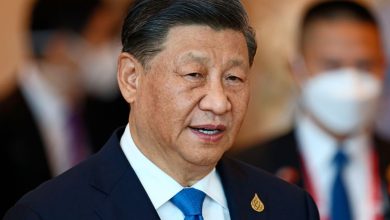Here’s what is really behind OPEC+ oil-production cuts, say energy analysts

[ad_1]
An unexpected production cut announced on Sunday by OPEC+ oil producers complicates strained relations between the U.S. and Saudi Arabia, with investors seeing signs of geopolitical posturing in the decision.
However, some market analysts contend the cuts were less about sending a message to Washington and more about stabilizing oil prices amid fears of recession, as well as protecting the supply and demand balances.
See: 6 things investors need to know about the surprise OPEC+ production cuts
Saudi Arabia and other members of the Organization of the Petroleum Exporting Countries on Sunday announced they would slash a further combined 1.16 million barrels per day of oil production from May until the end of 2023. Russia, stinging from price caps and embargoes on its energy products as a result of its invasion of Ukraine, said it would extend its 500,000 barrel-a-day production cut through year-end. Together OPEC and its allies, led by Russia, make up the group known as OPEC+.
Some news reports and market analysts have speculated that the surprise move was motivated by geopolitics and Saudi Arabia’s fraying ties with the United States.
U.S. Energy Secretary Jennifer Granholm said in March that the U.S. would not replenish the Strategic Petroleum Reserve because of maintenance at two of the four sites. The Financial Times reported, citing people familiar with Saudi Arabia’s thinking, that Riyadh was “irritated” by that comment.
OPEC+ in October announced a similar cut of 2 million barrels per day, equal to 2% of global supply, saying it was necessary to respond to rising interest rates in the U.S. and a weaker global economy. The call prompted President Biden to accuse the country of sliding with Russia in an attempt to trigger an energy crisis, while vowing “consequences” for Saudi Arabia.
This time, however, Washington offered a more muted reaction.
“It’s really different dynamics in Washington with this cut, compared to the cut last October. Back then you had this bipartisan outcry with everything from arm sales to the No Oil Producing and Exporting Cartels (NOPEC) legislation, even talking about re-evaluating the relationship [with Saudi Arabia],” said Clay Seigle, director of global oil service at Rapidan Energy Group.
Oil futures failed to get a lasting lift from the October production cuts, drifting lower into December and then holding a sideways trading range before dipping to new lows last month.
Though remarks by policy makers have been much more muted following Sunday’s announcement, the cut does raise the prospect of rising tensions between Washington and Riyadh in the near future, said Seigle.
“Imagine in the future if the Federal Reserve cites this supply cut as inflationary and a reason why rates need to stay higher for longer, and that in turn causes a recession, then tensions between Washington and Riyadh could be right back on the simmer,” Seigle told MarketWatch in a phone interview.
The decision was certain not to be welcomed by the White House, but the bottom line is Washington and Riyadh simply have “different price targets for their key policy initiatives,” said Helima Croft, head of global commodity strategy at RBC Capital Markets, in a Sunday note.
Saudi Arabia has prepared to endure increased friction in the bilateral relationship since President Biden’s visit to Jeddah last August, when Washington did not get the production increase it was seeking, Croft wrote.
“The United States is now seen as just one of several partners, and that the bilateral relationship with China is rising in importance. China is already the Kingdom’s most important trading partner and the country’s economic future is seen as residing in the East,” she said.
See: What surprise oil-production cuts mean for the Fed’s rate plans and markets
Ann-Louise Hittle, head of macro oils at Wood Mackenzie, said the move is necessary for OPEC+ to stabilize the market after recent U.S. bank failures revived fears of a financial crisis and a global recession.
In March, oil futures plunged to below $70 a barrel for the first time since December 2021.
“From an OPEC+ point of view, the cut was done to trigger a move back up to where prices were. We are now back in the low $80s for Brent. So they’ve succeeded. They knew the market needed a jolt in order to get out of its post-Silicon Valley Bank low,” Hittle said.
Global benchmark June Brent oil
BRN00,
BRNM23,
settled at $84.94 a barrel on ICE Futures Europe on Tuesday, the highest since March 6. West Texas Intermediate crude for May delivery
CL00,
CLK23,
finished at $80.71 a barrel on the New York Mercantile Exchange. That was the highest front-month settlement since Jan. 26, according to Dow Jones Market Data. Both Brent and WTI jumped more than 6% Monday in reaction to the production cuts.
Analysts think OPEC+ also cut output due to concerns that oil demand growth may not come through for the second half of 2023.
“A move like this, especially the voluntary cuts by a subset of the full group, is designed to add credibility to shoring up supply…They’re really trying to protect balances going forward and want to make sure that we aren’t moving into a structural oversupply situation, but it is risky because it could overtighten the market,” Seigle said.
Traders have bet on a sharp rebound in oil demand since the start of 2023 as China eased COVID-19 restrictions and opened up the world’s second biggest economy in December.
Marko Papic, chief strategist at the Clocktower Group, told MarketWatch that Chinese demand for oil is going to come back and offset the concerns about “a global or a U.S. recession that the Saudis are responding to,” which also leads to higher oil prices.
However, Hittle said there’s a lot of fear in the market that China’s “great recovery” will not occur, and there is underlying concern that U.S. oil demand will also suffer due to a potential recession, “so the market and OPEC are not unreasonable to think that there’s this risk of that happening,” Hittle told MarketWatch in an interview.
[ad_2]
Source link



